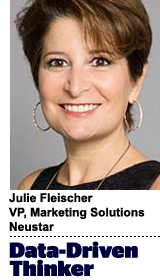 “Data-Driven Thinking” is written by members of the media community and contains fresh ideas on the digital revolution in media.
“Data-Driven Thinking” is written by members of the media community and contains fresh ideas on the digital revolution in media.
Today’s column is written by Julie Fleischer, vice president of marketing solutions at Neustar.
We’ve all heard the stats. There are 2.5 quintillion bytes of data created each day. Ninety percent of the world’s data was created over the last two years.
We are drowning in data but starved for insights. If there is one thing everyone agrees on, it’s that the volume of data that’s being created, collected and cultivated is increasing exponentially.
And yet, now there is a new conversational thread emerging: We’re not drowning in data – we’re preparing to starve. The spigots are being closed, and we’re entering the era of the data drought.
This theory says, sure, data has been cheap and plentiful, but now the best data is getting stuck behind dams being established by the General Data Protection Regulation (GDPR) and walled gardens that are changing the rules so that they can hoard IDs and preclude leakage. Google Ads Data Hub and the blocking of ID sharing are two primary early warning signs offered of an impending data drought.
If we are indeed entering a period of drought where the early green shoots of our data-driven future shrivel up and die, this will be a huge problem for the industry. Advertisers must see the impact of their advertising – verify delivery, control frequency, measure impact – in order to value their spend and remain accountable for their marketing investments. Publishers, networks and platforms owe advertisers the same accountability. Without good data, accountability – and the whole marketing ecosystem – crumbles.
So which is it? Drought or deluge? Famine or feast? Is our industry on-trend or off the tracks?
First, let’s explore the mindset that’s shaping the view that the data stream is collapsing on itself. Some believe that the scale of a walled garden data dam makes it inevitable that the industry will be negatively reshaped. They see a direct line between DoubleClick changes and advertisers’ fortunes.
But in reality, brands have options which can help them grow their data footprint even as DCM (now Google Ad Manager) flexes its muscles. More on that in a minute, but before we get to options, it’s important to pressure-test the assertion: Are we actually seeing a data drought? No.
I see more of a flood than a drought. Year over year, I am consistently seeing more data created. It actually resembles a hockey stick, with exponentially more data created and delivered each year as money shifts to addressable or trackable data, to walled gardens, and as walled gardens offer data for measurement programs.
Now, I certainly acknowledge that not all data is equally valuable. Advertisers must consider all aspects of data: velocity, variety, volume and validity. But even so, measurement programs were established at Facebook (2016), Pinterest (2017) and for linear TV and clean rooms (2018), which enable data access to important high-quality data.
The time is ripe for marketers to build accountability and ensure access to the free-flowing, high-value data they need for better results and more transparent accountability. They must ask more for their advertising dollar and push for a privacy-compliant data pass-back with any buy. The days of investing money and accepting delivery blindly are over. Where advertisers’ needs aren’t considered, advertisers must let their dollars do the talking as they reinvest them elsewhere.
More immediately, advertisers need to protect their ability to secure privacy-compliant data today, now that Google Ad Manager’s policy changes have gone into effect.
If an advertiser chooses to stick with Google Ad Manager, it can add additional tracking like an authorized pixel- and click-tracking solution to ensure accountability is maintained. The data generated by that pixel should be used as the source of truth.
If the strategy is to shift from Google Ad Manager to another ad server that does not dam data, there are several options. For instance, Flashtalking and Sizmek are both positioning themselves as data-rich Google Ad Manager alternatives. Google Ad Manager is currently the market leader and built into the infrastructure of many agency models, which has given Google the market power to make the move to withhold valuable advertiser data. As such, the switching costs many be high, but for data-driven advertisers, the cost of not switching may be higher.
This is a great opportunity for advertisers to take a position in support of their data-driven future. The effectiveness of media investment requires visibility and accountability. Whether you are bullish or bearish about the prospects of access to data, now is the time to build a strategy, the governance and a tracking system so that advertisers can control their own destiny.
Follow Neustar (@Neustar) and AdExchanger (@adexchanger) on Twitter.
This post was syndicated from Ad Exchanger.


More Stories
How A Digital Media Agency Built Its Own AI-Powered Contextual Targeting Tool
Rockit Global: The NZ Marketing Awards allows us to share our story
David Yurman Names PHD Global Media Agency of Record